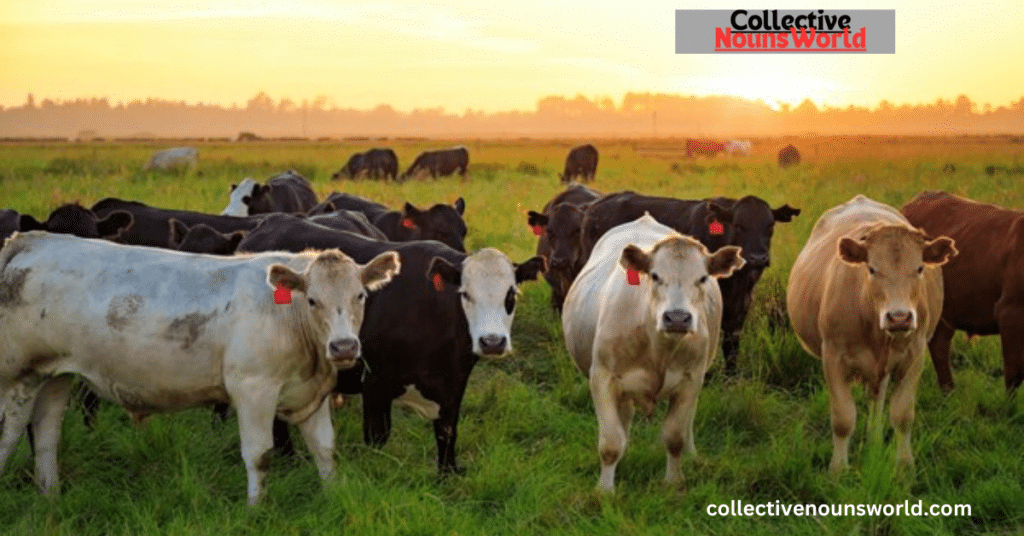The Amazing World of Cows: Discover Collective Noun for Cows
Imagine standing in a lush, green field on a warm summer day. The air is filled with the gentle lowing of cattle and the sweet scent of fresh grass. As you gaze across the landscape, you see a group of cows grazing peacefully. But wait—what do you call this gathering of bovines? Is it just a group, or is there a more specific term?
Welcome to the fascinating world of collective nouns for cows! These special terms not only add color to our language but also provide insights into the historical and cultural significance of these beloved farm animals. In this article, we’ll explore the various collective noun for cows, their origins, and how they’re used in different contexts.
Before we dive into the specifics, let’s take a look at some of the most common collective nouns for cows:
| Collective Noun | Usage Context |
| Herd of cows | General term for a group of cattle |
| Drove of cows | Typically used for cows being moved or driven |
| Kine of cows | An archaic term, rarely used today |
| Team of cows | Used when cows are working together |
| Mob of cows | Informal term, often for a disorderly group |
Now, let’s explore each of these terms in more detail and see how they’re used in everyday situations.
Read more What is the Collective Noun for Papers?
The Classic: Herd of Cows
The most common and widely recognized collective noun for cows is a “herd of cows.” This term is used to describe any group of cattle, regardless of size or purpose. Whether you’re talking about a small family farm or a large commercial operation, “herd” is the go-to word for a group of bovines.
Example scenario: Imagine you’re a city dweller visiting your cousin’s farm for the first time. You might send an email like this to your friend back home:
To: cityfriend@email.com
Subject: Farm life is amazing!
Hey Sarah,
You won’t believe what I saw today! My cousin took me out to the pasture, and there was this huge herd of cows grazing. I’ve never seen so many cows in one place before. It was like a sea of black and white spots!
I even got to help move the herd to a different field. Can you imagine me, a city slicker, herding cows? It was hilarious and awesome at the same time.
Wish you were here to see it!
Best,
Alex
On the Move: Drove of Cows
When cows are moving or being driven from one place to another, you might hear the term “drove of cows.” This collective noun has its roots in the historical practice of cattle drives, where cowboys would move large numbers of cattle across long distances.
Example scenario: Picture a local newspaper reporting on a traditional cattle drive event:
HEADLINE: Annual Cattle Drive Brings Traffic to a Standstill
OAKVILLE, TX – Residents of Oakville were treated to an unusual sight yesterday as a drove of cows made their way down Main Street. The event, part of the town’s annual Heritage Days celebration, saw over 100 cattle being driven through the heart of the town.
“It’s not every day you see a drove of cows coming through downtown,” said Mayor Linda Thompson. “It really brings our history to life and reminds us of our ranching roots.”
The cattle drive, led by local rancher Bob Johnson and his team, took about an hour to complete. Traffic was redirected during the event, but most residents didn’t seem to mind the delay.
“Watching that drove of cows go by was worth every minute of waiting,” said longtime resident Tom Baker. “It’s something you don’t forget in a hurry.”
Read more Fun with Collective Noun for Shoes
A Blast from the Past: Kine of Cows
“Kine of cows” is an archaic term that you’re unlikely to hear in everyday conversation. It’s an Old English term for cows that has fallen out of use but still pops up occasionally in historical or literary contexts.
Example scenario: Imagine a university professor sending an email to her students about an upcoming literature assignment:
To: english201@university.edu
Subject: Old English Literature Assignment
Dear Students,
For next week’s class, we’ll be delving into the world of Old English literature. I’d like you to read the poem “The Cattle-Raid of Cooley” and pay special attention to the language used to describe cattle.
You’ll come across the term “kine of cows” in the text. This archaic collective noun was commonly used in Old English to refer to a group of cattle. As you read, consider how the use of such terms contributes to the overall tone and setting of the piece.
Be prepared to discuss your thoughts in class!
Best regards,
Dr. Emily Wordsworth
Read more What is the Collective Noun for Keys?
Working Together: Team of Cows
When cows are pulling plows or working together for a specific purpose, they might be referred to as a “team of cows.” This term emphasizes the cooperative nature of the animals and is often used in agricultural contexts.
Example scenario: Picture a historical reenactment event where visitors can see traditional farming methods in action. A tour guide might explain:
“And here, folks, we have a demonstration of plowing with a team of cows. In the days before tractors, farmers relied heavily on their cattle not just for milk and meat, but also as a source of power for working the land.
This team of cows is pulling a traditional wooden plow. It takes skill and patience to guide them, but these sturdy animals can turn even the toughest soil. Watch how the farmer uses voice commands and gentle touches to direct the team. It’s a beautiful example of the partnership between humans and animals that has shaped agriculture for thousands of years.”
The Unruly Bunch: Mob of Cows
For a group of cows in disorderly manner, you might hear the informal term “mob of cows.” This collective noun often implies a sense of chaos or unpredictability.
Example scenario: Imagine a local farmer, Bob, recounting a funny story to his neighbor:
“You’ll never believe what happened yesterday, Joe. I was out in the south field, minding my own business, when I heard this commotion. I turned around, and there was this mob of cows heading straight for my vegetable garden!
I don’t know how they got out, but there they were, a whole mob of ’em, trampling through my prize tomatoes. It was like they were on a mission to destroy every last vegetable I had.
I was running around like a headless chicken, trying to herd them back to their pasture. Must’ve been quite a sight—old Bob chasing a mob of cows around the garden. Took me a good hour to get them all rounded up and back where they belonged.
Needless to say, I’ll be double-checking those fence gates from now on. Can’t have another mob of cows staging a raid on my veggies!”
Read more What is the Collective Noun for Girl?
Beyond the Basics: Other Ways to Describe Groups of Cows
While the terms we’ve discussed are the most common, there are other ways to describe groups of cows in specific situations. Let’s explore a few:
- Cows in the field: When describing cows grazing peacefully in a pasture, you might simply refer to them as a group. For example, “The group of cows in the field made for a picturesque scene.”
- Cows and milk: In a dairy farming context, you might hear about the “milking herd.” This refers specifically to the cows that are currently producing milk. For instance, “The milking herd is headed to the milking area for their afternoon session.”
- Cows in the countryside: When describing the rural landscape, you might hear about “scattered herds.” This paints a picture of multiple small groups of cows spread across the countryside.
- Parade with cows: In some cultural events or festivals, you might see a “procession of cows.” This orderly line of cattle is often decorated and paraded through town as part of a celebration.
- Cows in the garden: If you’re unfortunate enough to find cows in the garden, you might humorously refer to them as an “invasion of cows.”
Teamwork Makes the Dream Work: Team of Cows
When cows pulling plows or working together comes to mind, we might use the term team of cows. This collective noun emphasizes cooperation and purpose.
Imagine a school project where kids are learning about farming history. Little Timmy might present his findings like this:
“In the olden days, before tractors, farmers used teams of cows so the help them work the land. They would hook up a team of cows to a big plow and walk behind them to make long lines in the dirt for planting seeds. It was hard work, but the cows were so strong and could pull heavy things for a long time without getting too tired.
The term “team” brings to mind images of cows in the field, so not just grazing, but actively contributing to farm work. It’s a reminder of the long history of partnership between humans and cattle.
The Cultural Significance of Cows and Their Collective Nouns
Cows have been an integral part of human society for thousands of years, and this is reflected in our language. The variety of collective nouns for cows demonstrates their importance in different aspects of life:
- Agriculture: Terms like “herd” and “drove” reflect the practical aspects of cattle farming.
- History: Words like “kine” give us a glimpse into the evolution of language.
- Community: Collective nouns like “mob” or “invasion” often come with stories that are shared within communities, strengthening social bonds.
Conclusion:
As we’ve explored the various collective noun for cows, we’ve seen how these terms add depth and color to our language. From the common “herd of cows” to the more specialized “drove of cows” or the archaic “kine of cows,” each term paints a vivid picture and carries its own connotations.
Next time you’re driving through the countryside and spot a group of cows, take a moment to consider: Is it a peaceful herd grazing in the field? A drove being moved to fresh pasture? Or perhaps a team working together to plow a field? Each term offers a unique lens through which to view these fascinating animals and their relationship with humans.

Luna Jasper is an experienced blogger with a passion for language and grammar. At **Collective Nouns World**, she shares her expertise in exploring the fascinating world of collective nouns, making learning both engaging and fun. With years of writing and research under her belt, Luna’s insightful articles help readers understand and appreciate the English language.







